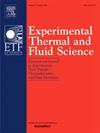Experimental study of the nonisothermal gas-liquid two-phase heat transfer characteristics in a rectangular helical channel
IF 2.8
2区 工程技术
Q2 ENGINEERING, MECHANICAL
Experimental Thermal and Fluid Science
Pub Date : 2024-12-12
DOI:10.1016/j.expthermflusci.2024.111393
引用次数: 0
Abstract
In this study, the nonisothermal two-phase heat transfer in the rectangular helical channel is proposed to effectively reduce the heat transfer losses in the single screw expander. The interphase heat transfer rate and temperature distribution of the nonisothermal gas-liquid two-phase flow in the rectangular helical channel are experimentally investigated under different gas-liquid flow rates, gas phase temperatures, and dimensionless pitch and curvature. The results indicate that increasing Rel and Reg will enhance the interphase heat transfer rate, and the effect of Rel on the heat transfer rate is gradually weakened at a larger Re. A further increase in Reg obviously increases the interphase heat transfer rate, but it has little influence on the peak temperature and temperature distribution of the gas. The interphase heat transfer rate is much higher for the helical channel with γ = 0.145. A maximum reduction of 28.5 J/s in the interphase heat transfer rate is obtained by decreasing the curvature ratio of the helical channel from 0.145 to 0.129. Furthermore, a maximum reduction of 36.5 J/s in the interphase heat transfer rate is obtained by decreasing the dimensionless pitch of helical channel from 0.9 to 0.5.
矩形螺旋通道内非等温气液两相换热特性的实验研究
为了有效降低单螺杆膨胀机的传热损失,本研究提出了矩形螺旋通道内的非等温两相换热。实验研究了在不同气液流速、气相温度、无量纲螺距和曲率条件下,矩形螺旋通道内非等温气液两相流动的相间换热速率和温度分布。结果表明:增大Rel和Reg均能提高气相间换热速率,且Rel对换热速率的影响在Re较大时逐渐减弱。进一步增大Reg可明显提高气相间换热速率,但对气体峰值温度和温度分布影响不大。当γ = 0.145时,螺旋通道的相间换热率更高。将螺旋通道曲率比从0.145降低到0.129,最大可降低28.5 J/s。将无量纲螺距从0.9减小到0.5,相间换热速率最大可降低36.5 J/s。
本文章由计算机程序翻译,如有差异,请以英文原文为准。
求助全文
约1分钟内获得全文
求助全文
来源期刊

Experimental Thermal and Fluid Science
工程技术-工程:机械
CiteScore
6.70
自引率
3.10%
发文量
159
审稿时长
34 days
期刊介绍:
Experimental Thermal and Fluid Science provides a forum for research emphasizing experimental work that enhances fundamental understanding of heat transfer, thermodynamics, and fluid mechanics. In addition to the principal areas of research, the journal covers research results in related fields, including combined heat and mass transfer, flows with phase transition, micro- and nano-scale systems, multiphase flow, combustion, radiative transfer, porous media, cryogenics, turbulence, and novel experimental techniques.
 求助内容:
求助内容: 应助结果提醒方式:
应助结果提醒方式:


